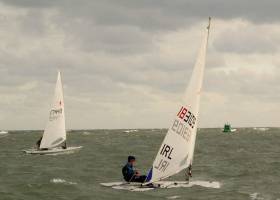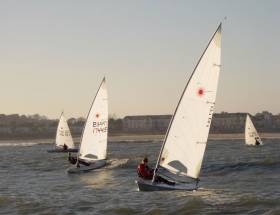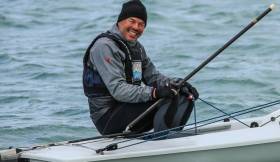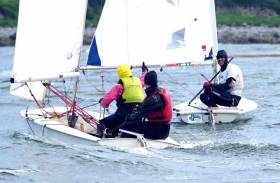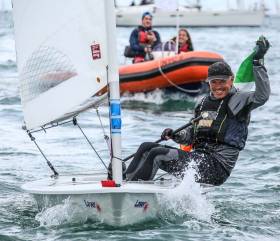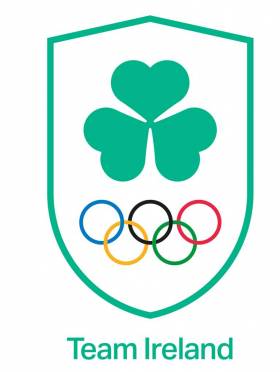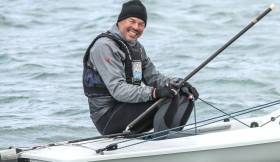Displaying items by tag: Laser
Wallace Extends Lead at Howth Yacht Club Frostbites
Easterlies were in place again for this weekend’s Laser action in Howth. Unlike last weeks’ pleasant smooth rolling sea, the breeze was stronger and the ebb tide made for a steeper chop which was much harder work. With winds ranging from 17ts to 25kts, there was plenty of action for the rescue boats too, including a dramatic capsize to weather by your author in race 2. An eager fleet tested race committee patience with a general recall in race one, nicely recorded on video by Harry Gallagher. The fleet got away on the second start, with Conor Murphy leading at the first mark followed by Mike Evans and David Quinn. Evans and Quinn got through Murphy on the first lap with Evans establishing a nice lead on the second beat. Ronan Wallace sailed a superb first run to take the lead, which he kept to the finish. Mike Evans finished second with Quinn in third.
Wallace led from the start in race 2, with Dan O’Connell not far behind in second throughout the race. Mike Evans and Dave Quinn got tangled at the first weather mark (I was fully to blame after a terrible tack!!), leaving Daragh Sheridan to sail past the carnage and maintain third place to the finish. Ronan Wallace now has a commanding lead, winning 7 of the 8 races so far, with Dan O’Connell now lying second and Mike Evans in third overall.
In the Radial Fleet, Tom Fox continued his string of bullets, winning both races today, from Peter Hassett with 2 seconds. Sophie Kilmartin similarly dominates the 4.7 fleet, discarding a second after another 2 bullets yesterday.
Sean Craig Takes Third at Radial UK Inlands at Grafham, Mark Lyttle Fourth in Full Rig
Irish sailors were in the mix at the UK Laser Master Inlands at Grafham Water this weekend.
Royal St. George's Sean Craig took third overall in the Radials and in the much bigger fleet of Full rigs, the National Yacht Club's World Champ Mark Lyttle was edged out in a fairly tight finish between the top four overall.
The Dubliner gave a good talk on Saturday night recounting the recent Master Worlds and his 1996 Olympic campaign too.
Results from Grafham here
Wallace Has Commanding Lead of Howth Yacht Club Laser League
Week 3 of the Howth Yacht Club Laser Frostbites served up yet another perfect Autumn morning. Easterlies always add to the excitement in Howth with big waves rolling into the Sound from the Irish Sea. Numbers were down slightly this week, with post Rugby celebrations no doubt partly to blame!
The first race started with a steady 19kt breeze and Dan O'Connell showed his Masters Worlds form with a fast first beat to lead at the first weather mark. The first reach in big waves was exciting, with big gains to be made if you could stay on one the the rollers. Dan maintained a small lead from David Quinn throughout the race, with Ronan Wallace and Mike Evans also having a close tussle for 3rd. Tom Fox won the Radial fleet, and put pressure on many of the full rigs throughout the race. Carla Fagan took second
The breeze moderated slightly for race 2 with the ebb tide still encouraging the fleet to head left into the sound. David Quinn led at the first mark, and for the first lap, before Ronan Wallace overtook him on the second downwind. Wallace went on to win, with Quinn in second and Dan OConnell in third. Tom Fox won again in the Radial fleet, from Peter Hassett this time in second.
6 races into the series, Ronan Wallace has a commanding lead, with Mike Evans in second overall and David Quinn up to third. Tom Fox is dominating the Radial Fleet.
Tricky First Laser Dinghy Day for the Howth Frostbites
The first two races of the Howth Yacht Club Frostbites were held in beautifully mild but tricky conditions, with a 6-10 knot Southerly clocking right all morning. The key discussion point in the dinghy pen before racing was ‘hat or not’ as those new to Frostbite racing wondered what all the fuss was about.
Ronan Wallace set out his stall for the event with two race wins in the Standard Rig Fleet, with Dan O’Connell putting him under pressure throughout. Tom Fox of Rush Sailing Club won both races in the Radial Fleet.
Live trackers were used for the first time which will add hugely to the enjoyment of the event, but hopefully also add some useful data for the keen sailors! Full coverage of both races are available in the attached tracker link here
Onboard Trackers Introduced for Howth Yacht Club Laser Frostbites
Olympian Dan O’Grady and Tokyo Olympic campaigner Ewan McMahon are among the entries lined up for next month's 2018-2019 Laser Frostbites at Howth Yacht Club where onboard trackers will be used for the first time in the long-running series.
Howth's own Olympic Radial campaigner, Aoife Hopkins, is also going to race some of the series in her busy schedule.
The series starts on Sunday 4th Nov, and runs to 9th March 2019. Organisers have arranged the hire of onboard trackers this year. This will allow for superb debriefing and coaching opportunities along with plenty of post-race banter!
Format is largely the same with 2 races each Sunday morning (FG 10:45) just outside the Harbour.
The event always attracts a large entry with sailors ranging from Ex Olympians and current top Olympic campaigners to absolute beginners, across the 3 rig sizes. All are welcome.
Online entry now open here
Mark Lyttle, Olympic Sailor at Atlanta in 1996 when he won a race in the Laser’s first outing in its very effective career as an Olympic boat in addition to its myriad other duties worldwide, has continued his love affair with great little boat by winning the World Title in the Grand Masters Division (ages 55-65) in the Laser Masters Worlds in September at Dun Laoghaire, a magnificent event which attracted 302 entries. Lyttle’s win was particularly popular – in a long sailing career, he has put even more back into sport than he has taken from it.
The Smallest Boats To Sail Round Ireland – A Story of Courage & Character
The contrast could not have been greater writes W M Nixon. On Friday, September 14th on Ireland’s relatively sheltered East Coast, 302 Laser dinghies came in from Dublin Bay to Dun Laoghaire’s elegant and busy harbour to conclude the penultimate day’s racing in the Laser World Masters 2018.
And away to the west at the head of Galway Bay, a lone Laser came into Rinville to receive the enthusiastic greetings of a welcoming flotilla, and the homely embrace of Galway Bay Sailing Club.
Richard Hayes had completed his solo epic, a round Ireland voyage which had seen him log a total of 1,324 sea miles (2,452 kilometres) in 54 sailing days.
But they were by no means 54 consecutive sailing days. For he had happened to hit on just about the most awkward summer for sailing a Laser round Ireland that we’ve had for a decade, with many days unsuitable for sailing for various reasons, ranging from prolonged flat calm to two named storms – Hector and Ernesto – and going on to include seven days of impenetrable fog and three capsizes.
 The Ireland challenge. While a Laser can slip through inside Achill Island with no bother, and Richard Hayes was even able to avail of the old canal inside the Mullet Peninsula at Belmullet in northwest Mayo, there are long stretches of inhospitable coast where you just have to keep on sailing.
The Ireland challenge. While a Laser can slip through inside Achill Island with no bother, and Richard Hayes was even able to avail of the old canal inside the Mullet Peninsula at Belmullet in northwest Mayo, there are long stretches of inhospitable coast where you just have to keep on sailing.
He took his departure from GBSC at their Open Day on Sunday, May 27th, and sailed into an exceptionally lengthy period of windless high pressure. So totally calm was it that, with the need to find somewhere to stop each night, it took him ten days to get clear beyond Slyne Head from Galway Bay itself in order to start the first northward major stage of his clockwise circuit.
Already, it seemed likely that the circuit was going to take much longer than the eight-nine weeks he’d originally envisaged. That in itself would have deterred many, who would at the very least have postponed until a more favourable weather pattern began to develop. But this was no light-hearted venture undertaken on a whim – he was determined to simply keep going on until he got there.
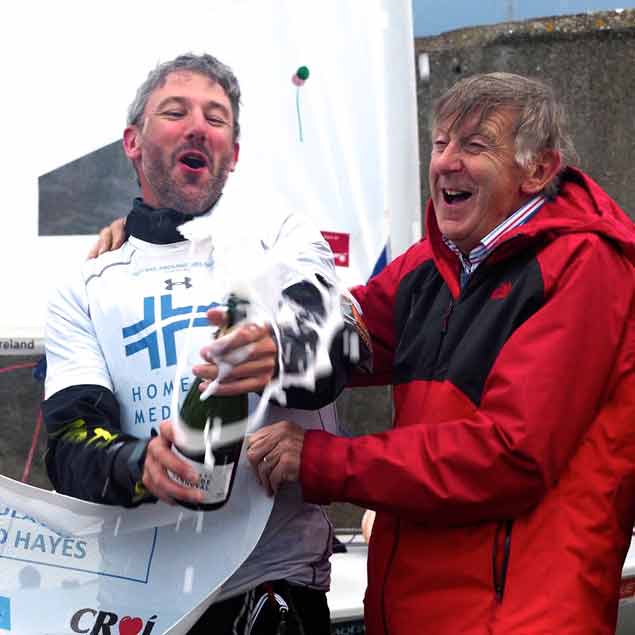 Richard and his father Michael celebrating the safe completion of the voyage at Galway Bay SC. While Michael drove 4,000 miles in all with the little Campervan in the hope of being able to provide shore support everywhere possible, there were inevitably stages where Richard was very much on his own. Photo GBSC
Richard and his father Michael celebrating the safe completion of the voyage at Galway Bay SC. While Michael drove 4,000 miles in all with the little Campervan in the hope of being able to provide shore support everywhere possible, there were inevitably stages where Richard was very much on his own. Photo GBSC
Richard Hayes – as the photos show – seems a perfectly normal 40-something, as ready for a laugh and good company as the next man. Yet there’s a serious and thoughtful side to him, and two or three years ago, thanks in part to his work in Galway as a Chartered Physiotherapist, he became even more aware of the woeful lack of provision for cardio-vascular problems, and particularly the shortage of defibrillators and trained users at key locations. So the idea developed of a very special fund-raiser in support of the Galway-based CROI Heart & Stroke Charity, and it increasingly became something which had to be done before he could get on with the rest of his life.
Doing it through a very special sailing achievement seemed the most natural way. From Tipperary originally, he was introduced to sailing at the age of eight by his late mother on Lough Derg, and was soon in the thick of it, active on the junior racing front at events all over Ireland.
He showed a talent for teaching sailing, and in 1993 was signed on for a summer as Junior Instructor at Galway Bay Sailing Club. The West Coast soon had him in thrall, though his sailing experience was widening to include cruiser-racing in Galway, Cork and Dublin, while a spell in America saw him actively crewing several boats, the largest a fifty footer.
 Galway Bay SC, Richard Hayes’ “Home-from-Home” club. Photo: GBSC
Galway Bay SC, Richard Hayes’ “Home-from-Home” club. Photo: GBSC
But Galway was always where it was going to be despite his ties to his boyhood home, such that even after 15 years of living and working in the western city, he still refers to Lough Derg YC as his “home club” and Galway Bay SC as his “home-from-home” club. He was drawn to the health field and particularly physiotherapy, an interest to which the fairly athletic Laser sailing gave an added edge. And the Laser in turn provided the vehicle to make his fund-raiser a manageable proposition. As the various sections of the project were worked into place, he received direct sponsorship support for the voyage itself from Homecare Medical, Galway Crystal, Optique and the renowned Mary’s Fish Shop in the city, while the national names which chipped in included CH Marine, Dubarry and Marine Parts Direct.
As we shall see, solo-sailed Lasers have been taken round Ireland before. Indeed, there’s even a boat a tiny bit shorter in overall length which had done the circuit, albeit with two on board for most of the venture, and a shorter circumnavigating sailboard too. But there’s something about the perfection of the 4.2 m (13ft 9in) Laser which chimes so well with the unique demands of a round Ireland voyage that when it is done with a Laser, it is always as though it is being done for the first time.
You’re so closely in touch with nature, and yet still seeing it from the slightly separated world of a boat, that sailing a Laser round Ireland is to a significant extent a spiritual thing. It’s probably as near as a modern boat can come to providing a meaningful link to the voyaging monks of our ancient history, and their astonishing achievements along and away from the Irish coast in frail currachs.
It’s something which seems in no way diminished by the availability of modern communications, because for very long periods, no matter how much shore support you’re receiving, you’re inevitably very much on your own. This was emphasised in Richard Hayes’ case, for although his father Michael gave over his summer to driving a well-used campervan along the coast to be there when his son came into port, the roads by no means closely follow the shore, and some of the tiny gaps in the cliffs the Laser had to seek shelter in were unreachable by road.
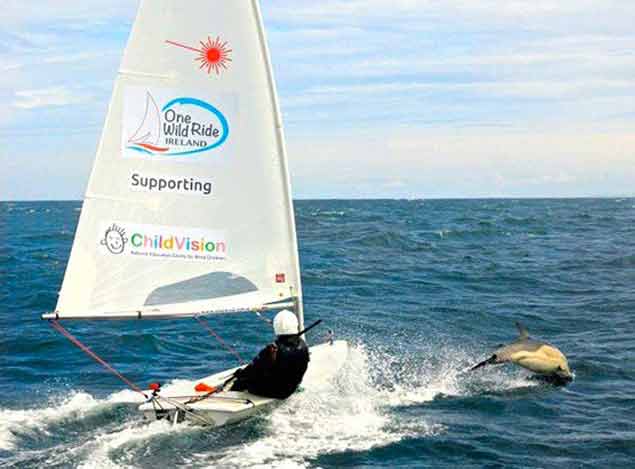 Gary ‘Ted’ Sargent – complete with safety helmet – on his way solo round Ireland in 2016. In addition to the company of dolphins, he had a support boat. Photo courtesy Gary Sargent
Gary ‘Ted’ Sargent – complete with safety helmet – on his way solo round Ireland in 2016. In addition to the company of dolphins, he had a support boat. Photo courtesy Gary Sargent
Unlike his friend Gary ‘Ted’ Sargent of Howth, who did the Laser Ireland circuit from Schull to Schull in 2016 as a fund-raiser for the charity ChildVision with an on-water support team somewhere nearby with a RIB, Richard Hayes’ voyage for CROI was done without any support team afloat, though from time to time along the coast, he would get friendly supportive company from other boats.
Basically, he’d decided it would be more manageable on his own at sea, with his father Michael as near as possible (and sometimes it’s not really near at all) with the Campervan. Thus the planning beforehand included the detailed study of aerial photos of the coast, particularly the many sections dominated by cliffs, where prior knowledge of even the tiniest possible landing place hidden in the coastal wall could be a life-saver in the event of a sudden deterioration in the weather.
Although he was on his own at sea, it was very much a family effort, with his sister Libhin continually monitoring him remotely on a choice of two tracking devices, while his other sister Michelle was on admin and is continuing with the fund-raising, which is ongoing and eventually hopes to raise €15,000 for CROI – you can contribute to it here
Along the coast, his father Michael’s patience and supportive enthusiasm was a great strength, for the voyage gathered its own momentum, and Richard found himself being conveyed to interviews with local radio stations and other centres of communication, such that he has arrived back with an even stronger belief in the good heart of Ireland’s smaller communities, and the complete, generous and unquestioning kindness of strangers who took him into their homes and provided for his every need, reinforced by the way in which they readily accepted that he and his family should be doing a thing like this.
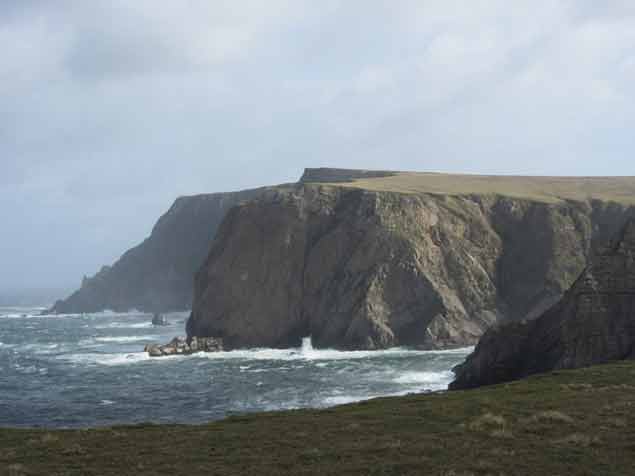 The unforgivingly grim cliffs of North Mayo. Richard reckons that when you’re spending a lot of time sharing space with a coastline like this, sometimes it’s better to concentrate entirely on your own little world in sailing the boat
The unforgivingly grim cliffs of North Mayo. Richard reckons that when you’re spending a lot of time sharing space with a coastline like this, sometimes it’s better to concentrate entirely on your own little world in sailing the boat
Speaking to him through this past week has possibly been too soon after the experience to expect his thoughts and recollections to be fully processed. Perhaps they never will be fully processed – maybe he’ll always find that there’s some new angle on a thought or experience which will develop beneficially. But certainly in speaking with him it seemed that here indeed was someone whose body had moved through so much experience that it was still waiting for his soul to catch up……
That catching-up of the soul will be an enriching experience. But as it is, his memories – a colourful bundle of contrasts – tumble out. Although he started in what became an all-pervading calm over most of Ireland, up in northwest Mayo and Donegal he found – as many have before – that they have their own weather systems entirely. But one of the joys of sailing a Laser on a project like this is that you can simply go inside islands inshore and offshore which have to be taken on the outside by deep-draughted high-masted boats, and thus he blithely went through Achill Sound without needing to wait for a bridge-opening, and equally he was able to avail of the almost-forgotten fact that there’s a canal at Belmullet inside the Mullet peninsula, closed off to most boats by a road bridge, but no problem for a Laser.
However, north of Belmullet the heavily-cliffed Mayo coast is daunting in the exteme, and it looked so grim with visibility closed in that Richard said the best thing was to put looming cliffs out of his mind for a whole, concentrate on the sailing and find a safe haven in Portacloy, which he duly did. If you’ve ever been to the remote cliff haven of Portacloy, you’ll know it’s not the sort of place you’d associate with the fun sailing of a little Laser.
 A major turning point is finally reached – approaching Fair Head, Ireland’s most northeasterly point. Photo: Richard Hayes
A major turning point is finally reached – approaching Fair Head, Ireland’s most northeasterly point. Photo: Richard Hayes
But as he gradually made his way along the much indented coast of Donegal, monumental coastlines became part of the daily visual diet – it’s big country. And it by no means fades to domestic scale as you get on to the north coast – everything is rugged until you get right round to Belfast Lough, when the prosperously green County Down coast is such that sometimes the Mountains of Mourne seem more like garden ornaments than the real thing.
There was much windward work, and with his professional training, he was well aware that maintaining a virtually fixed position for hours and end in order to keep the Laser at optimum speed was physiotherapy hooliganism, so there were times, such as on a long leg on the wind laying along a coast, that he simply had to tack for a while for all that it wasn’t making ground, simply to let his muscles and bones stretch in a different direction. Then at other times with wind strengths fluctuating wildly, he’d have to be prepared to put into any nearby beach to change down the rig size.
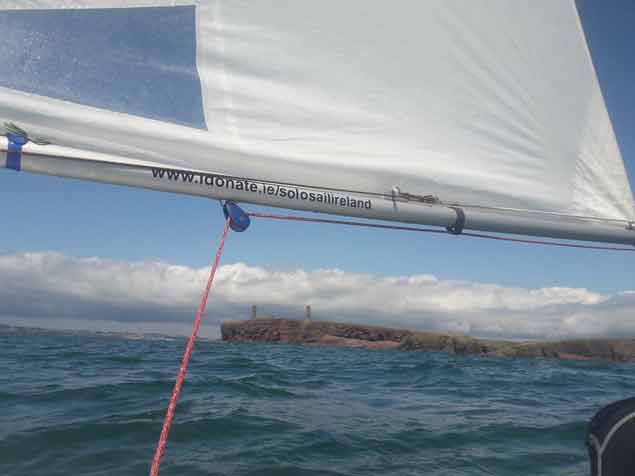 Onto the south coast at last, and approaching the headland at Tramore Bay with its three towers, one of which is topped by the famous Metal Man. This was a good passage-making day that began at Slade to the eastward of Hook Head in Wexford, and finished at Bunmahon along Waterford’s Copper Coast. Photo: Richard Hayes
Onto the south coast at last, and approaching the headland at Tramore Bay with its three towers, one of which is topped by the famous Metal Man. This was a good passage-making day that began at Slade to the eastward of Hook Head in Wexford, and finished at Bunmahon along Waterford’s Copper Coast. Photo: Richard Hayes
But then at the end of a day’s sail along less challenging coasts, he would shape his course for a useful little bay with a beach, and having passed the entrance to Cork Harbour he “made port” at Fountainstown, linked up with his father, and found ready new friendships ashore among those who live by the beach, including Sue McWilliam, wife of the recently-retired Des of the sail-making clan.
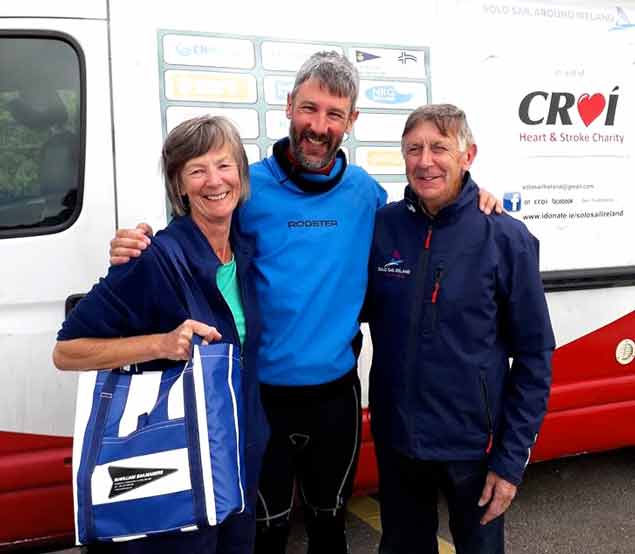 Friends met and made along the way….Sue McWilliam with Richard and Michael at Fountainstown Beach outside the entrance to Cork Harbour. Photo courtesy Richard Hayes
Friends met and made along the way….Sue McWilliam with Richard and Michael at Fountainstown Beach outside the entrance to Cork Harbour. Photo courtesy Richard Hayes
Such moments of friendly contact ultimately emphasised how necessary it was to press on if conditions suited next day, but in time he got round the Old Head of Kinsale and down to West Cork, stopping among other places at Tragumna and then next day on west through Gascanane Sound and into Crookhaven, where everything came to a stop for days with dense fog and weather warnings.
The season was getting late by this stage, and the window was becoming very narrow by the time he got past the Mizen and on -with various stops - for the most westerly point at Blasket Sound, by which time Richard and his team might reasonably have hoped they were approaching the home stage. But County Clare was determined to severely test this Tipperary man with his Galway notions, and along the cliffs between Loop Head and Kilkee – an unbroken wall of rock you might well think – he was grateful to have the knowledge of a tiny cove from his prior research, for he came out of a capsize badly in need of somewhere to recover, and this secret ‘Hayes Haven’ was nearby and just the job for those in peril on the sea.
Eventually he got to Liscannor in North Clare with September well upon him, and no progress with Small Craft Warnings in abundance. But there was only a passage of just under fifty miles left. Admittedy it was along the Cliffe of Moher and past Doolin and along the Burren round Black Head and into Galway Bay past Ballyvaughan. Spectacular stuff. But he felt that with just one clear day he could knock it off.
 It doesn’t need an exceptionally large running sea for a Laser hull to become invisible when sailing the Atlantic. Photo courtesy Richard Hayes
It doesn’t need an exceptionally large running sea for a Laser hull to become invisible when sailing the Atlantic. Photo courtesy Richard Hayes
On Wednesday, September 12th, that day came, a brief day of sailing perfection - fair winds and many accompanying dolphins friendlier than he’d seen at any time during the voyage, and the 48 fantastically varied and dramatic sea miles to Galway city knocked off in less than eight hours, the passage of a lifetime.
There was a day to gather himself, and then the welcome home on Friday evening to Galway Bay Sailing Club. Richard Hayes had done his bit and then some, but the fund-raising continues.
That’s the way it is with sailing epics in the 21st Century. Charitable fund-raising is a given. It was the same with Gary Sargent’s circuit for ChildVision in 2016. And in both cases, it was also the Laser which was the gift itself which just kept on giving. For in 2016, the Laser also gave us Annalise Murphy’s Silver Medal at the Rio Olympics. And in 2018, in addition to Richard Hayes’ great voyage, the little boat gave us the Laser Masters Worlds, an event in the utmost spirit of generosity.
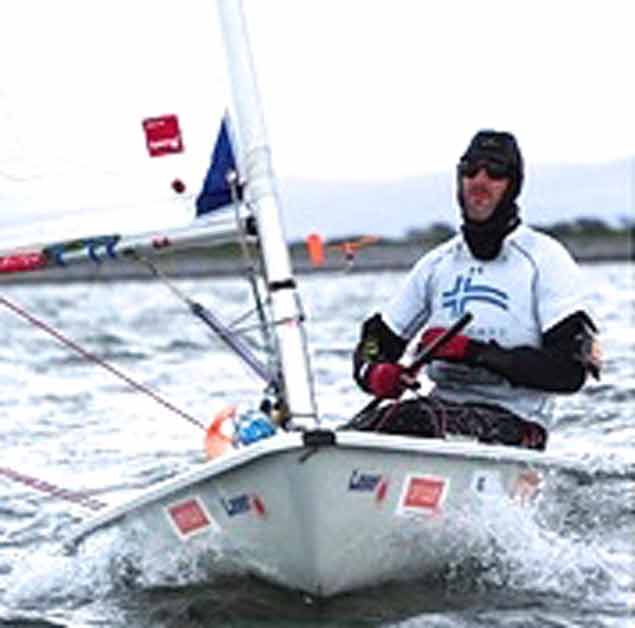 Into the final mile to the finish at GBSC
Into the final mile to the finish at GBSC
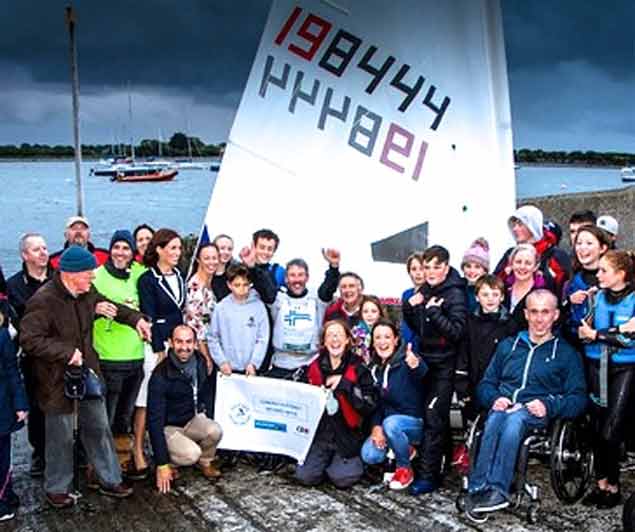 Welcome home and well done – the reception at GBSC
Welcome home and well done – the reception at GBSC
It all makes life in the 20th Century and way back in the previous Millennium seem almost buccaneering, for want of a better word. Back in the 1900s, if some somebody wanted to sail a small boat round Ireland, they just went off and did it, telling as few people – if any – as possible. Partly this was because the admittedly much more sparse officialdom of those days might have tried to prevent it, but it was also to save one’s parents from worry, because the west coast of Ireland in particular had a scary reputation.
Thus among young sailors it was thought quite something in 1961 when Kevin and Colm MacLaverty and Mick Clarke went round Ireland in three-and-a-half weeks in the 18ft Belfast Lough Waverley Durward. A Waverley is a bit like a carvel-built Mermaid made just one foot longer, and with a keel, which made Durward the smallest keelboat ever to go round Ireland.
 Back in the mists of time……..the 18ft Durward well into the latter half of her pioneering clockwise round Ireland circumnavigation in 1961, seen here in Sheephaven in Donegal with Colm MacLaverty and Mick Clarke on board. Photo: Kevin MacLaverty
Back in the mists of time……..the 18ft Durward well into the latter half of her pioneering clockwise round Ireland circumnavigation in 1961, seen here in Sheephaven in Donegal with Colm MacLaverty and Mick Clarke on board. Photo: Kevin MacLaverty
Yet a significantly smaller boat was to make the circuit unaccompanied in 1976. Thus was the unstoppable, inimitable James Cahill of Clew Bay, who took an open 13ft 6ins clinker sailing dinghy - which he’d built himself - right round Ireland, usually with one crew, but at some stages he was on his own. He not only survived, he subsequently thrived and made an Atlantic circuit cruise with a 42ft steel cutter Ricjak which he’d also built himself, and these days he cruises in a Maramu 54 ketch and is renowned for his extensive collection of Irish currachs, representing every known type.
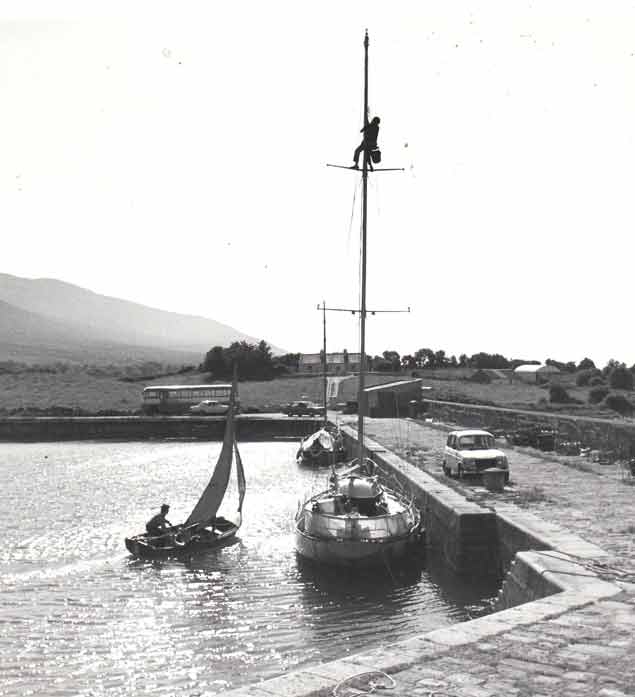 James Cahill bringing his 13ft 6ins sailing dinghy alongside Tad Minish’s yawl Kiff at Murrisk on Clew Bay in 1978, two years after he’d sailed the little boat round Ireland. Photo: W M Nixon
James Cahill bringing his 13ft 6ins sailing dinghy alongside Tad Minish’s yawl Kiff at Murrisk on Clew Bay in 1978, two years after he’d sailed the little boat round Ireland. Photo: W M Nixon
But then in 1981, Belfast Lough came centre stage again with Rob Henshall of Cultra, who went round Ireland alone in a canoe. There are other canoeists who have circled Ireland, but doing it solo is still in a class of its own. However, Rob Henshall was only getting started, for nine years later in 1990 he went round solo on a Laser. Not only was he unaccompanied by a support boat, but he had no means of non-visual contact with the shore, and no shore team either.
 Rob Hensall with the Laser he sailed round Ireland in 1990
Rob Hensall with the Laser he sailed round Ireland in 1990
He set himself very high if slightly crazy standards, for after the Laser episode he got to thinking of doing it on a sailboard. By this time he was a water-specialist instructor at the Gortatole Outdoor Education Centre in Fermanagh, but heaven alone knows what the powers-that-be might have made of his plan. For the core of it when he did it in 1992 was total self-reliance both afloat and ashore if need be, though when he reached shore he often found that kindness of strangers which is very much part of the Irish coastal experience.
He took a 3.7 m Bic sailboard which at 12ft 1in is the shortest vessel to have made the circuit, and despite loading himself with a backpack and the board with minimal but essential gear in a mainpack on the “foredeck”, he got round in 45 self-reliant days, losing two stone in weight in the process although he was definitely carrying no spare flab before he went.
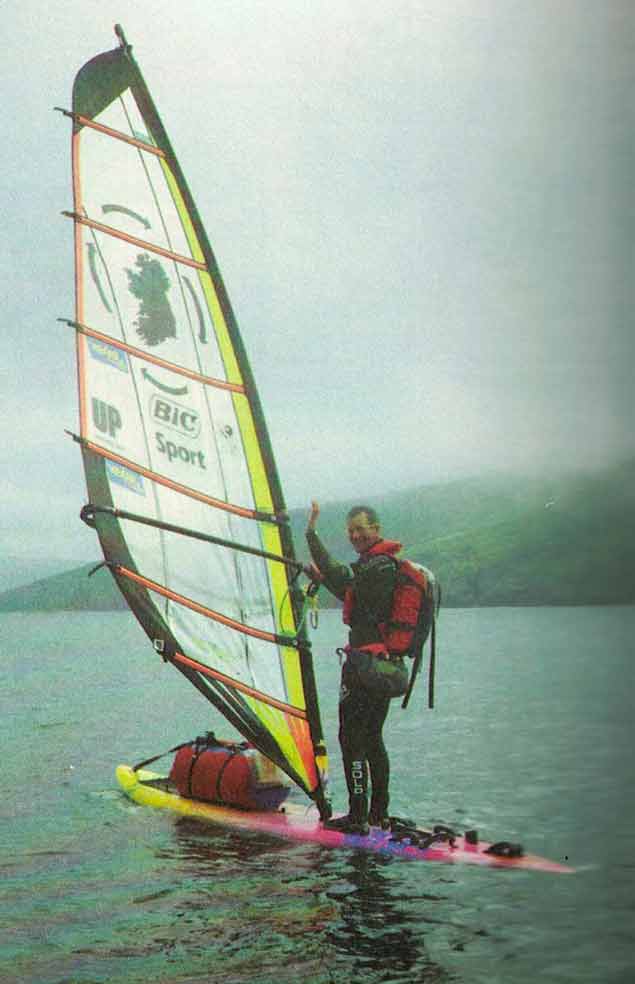 Will he ever get it to move at all? Rob Henshall departs on his heavily-laden Bic sailboard in 1992. Photo courtesy Rob Henshall
Will he ever get it to move at all? Rob Henshall departs on his heavily-laden Bic sailboard in 1992. Photo courtesy Rob Henshall
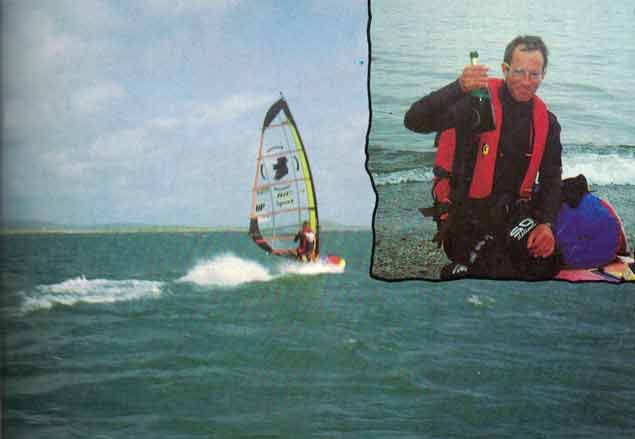 Yes he did get it to move……the laden Henshall sailboard making knots, with (inset) Rob relaxing when he completed another passage. Photos courtesy Rob Henshall
Yes he did get it to move……the laden Henshall sailboard making knots, with (inset) Rob relaxing when he completed another passage. Photos courtesy Rob Henshall
Since then, he too has settled down, but there was a flash of the old Rob Henshall a few years ago when the dollar was in freefall and the internet made the availability of bargain boats in America very accessible. So he nipped over in the Autumn and bought a 40ft ketch and simply sailed her straight across the ocean to his new sailing home in Lough Swilly. A Transatlantic passage in a medium-sized sailing boat when October is veering towards November does not accord with received opinion, but then very little of Rob Henshall’s seaborn activities ever did.
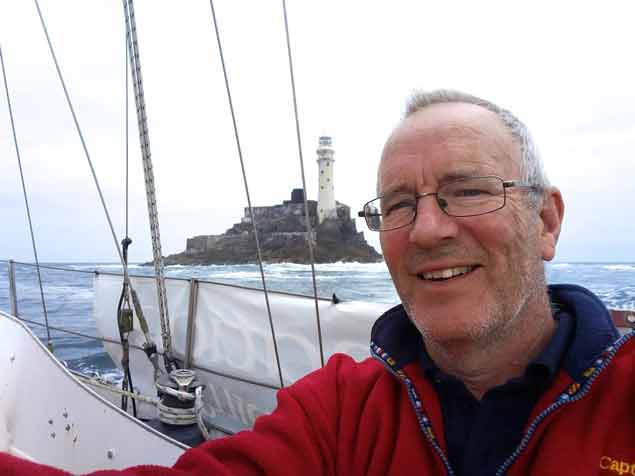 Rob Henshall as he is now, during a sail past the Fastnet Rock with his ketch Inspiration of Swilly. Photo courtesy Rob Henshall
Rob Henshall as he is now, during a sail past the Fastnet Rock with his ketch Inspiration of Swilly. Photo courtesy Rob Henshall
The fact that we are considering them again is thanks entirely to Richard Hayes’ great achievement. Think what you like about his voyage being made unaccompanied by a support boat, but it achieved its purpose in style. It showed courage and determination of a high order, it gave us a privileged glimpse into the life and dynamics of a very special family, and it was for a very worthy cause – that donation link again is www.idonate.ie/solosailireland
We can be quite sure that he and the others who made these special voyages endured considerable hardship and struggle at times. But now and again the conditions smiled on them, and we end on a high note with the vid from Richard’s final 50 mile passage from Liscannor round into Galway Bay. Shortly after he got to Galway Bay SC itself, the weather shut down completely, and has been going totally haywire ever since, so this glimpse of that vital final weather window is doubly precious here
As to the future, there’s a whisper that the three Laser solo circumnavigators may be having a get-together before Christmas. You’d guess that Comfort Zone Sailors need not apply…..
 Laser solo circumnavigator Gary ‘Ted’ Sargent celebrating at Schull on completion of his voyage in 2016. Photo: Tom MacSweeney
Laser solo circumnavigator Gary ‘Ted’ Sargent celebrating at Schull on completion of his voyage in 2016. Photo: Tom MacSweeney
National Yacht Club's Mark Lyttle Crowned Laser Grand Master World Champion on Home Waters
In a tense climax to the Laser Master World Championships in Dun Laoghaire this afternoon, Mark Lyttle won his first World Laser Title when he clinched the 66-boat Grand Master division on Dublin Bay, some 22 years after representing Ireland in the Laser class at the Atlanta Olympic Games.
Although Lyttle started the day with a six-point margin eeked out after a week of clever racing, home waters provided little local comfort for the Blackrock sailor who had to contend with an abandoned race when he had all his rivals safely behind him. Instead, in the dying airs of an Autumn afternoon, Lyttle finished just two points ahead of Spain's tenacious Carlos Martinez who won the final race of the 11-race regatta.
 Twenty-two years after becoming Ireland’s first representative in the then brand-new Olympic class, Lyttle (55) marked his return to Dublin Bay with a world title win Photo: Afloat.ie
Twenty-two years after becoming Ireland’s first representative in the then brand-new Olympic class, Lyttle (55) marked his return to Dublin Bay with a world title win Photo: Afloat.ie
Lyttle, who hails from the National Yacht Club and who was a race winner at the Atlanta Games, hit this Worlds event in an age sweet–spot (he’s just turned 55) and qualified for the GrandMaster division (the biggest fleet in the event) to win it on the first occasion.
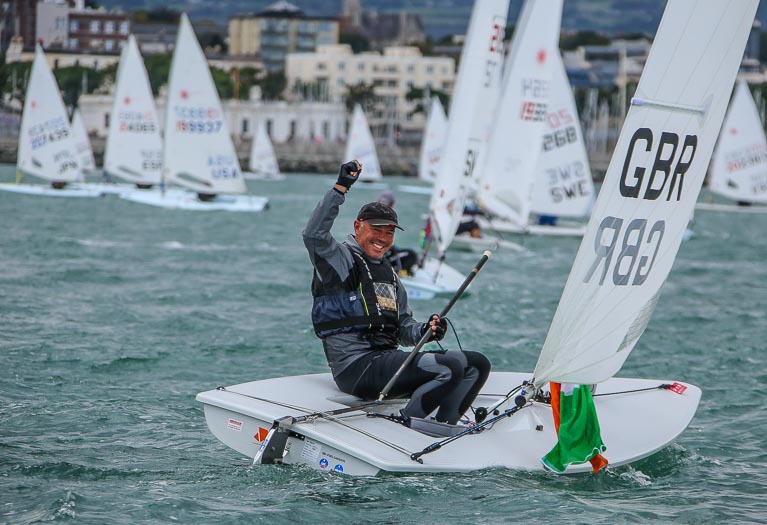 Lyttle, who lives and works in London, had to qualify for the Dublin Bay championships under the rules of the International Laser Class through his 'UK District' and therefore sailed the event with British 'GBR' sail letters but there's no mistaking the colour of the flag draped over his boom! Photo: Afloat.ie
Lyttle, who lives and works in London, had to qualify for the Dublin Bay championships under the rules of the International Laser Class through his 'UK District' and therefore sailed the event with British 'GBR' sail letters but there's no mistaking the colour of the flag draped over his boom! Photo: Afloat.ie
The Multi Irish champion won the UK Laser Masters Championships in June in some style, with six firsts in eight races but today's World title will easily eclipse that and its made all the sweeter by winning on home waters too!
Results here
After a touch and go battle with light winds on Dublin Bay, both course areas delivered a final race to round off the Laser Masters World Championships.
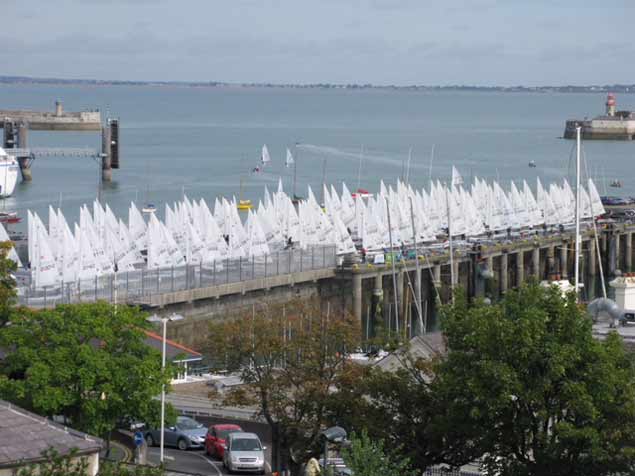 The World Laser Masters fleet, totalling 304 boats, made good use of the vacant Carlisle Pier at Dun Laoghaire Harbour Photo: Peter Wilson
The World Laser Masters fleet, totalling 304 boats, made good use of the vacant Carlisle Pier at Dun Laoghaire Harbour Photo: Peter Wilson
The eleventh race did little to alter the leaderboards with emphatic class wins in all but two fleets.
As reported above, Lyttle emerged victorious in the Standard Grand Master class despite placing seventh in the final. Sweden’s Tomas Nordqvist had been challenging for the top spot but had a 14th place that dropped him to fifth overall.
 NYC Celebrate their new world champion – Commodore Ronan Beirne (left) with Lyttle and Rear Commodore Susan Spain
NYC Celebrate their new world champion – Commodore Ronan Beirne (left) with Lyttle and Rear Commodore Susan Spain
There was a similar battle for the overall win in the Standard Apprentice class that ended the week-long match-race between Spain’s Leandro Rosado and Canada’s Gord Welsh with the Iberian sailor edging ahead by two points.
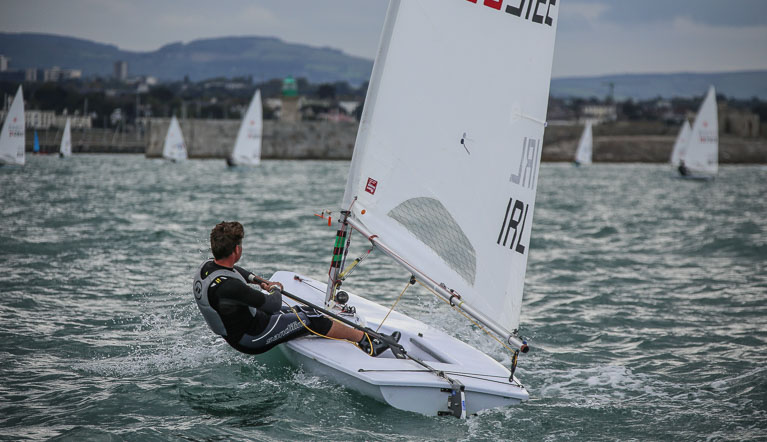 Ireland's Roger O'Gorman Photo: Afloat.ie
Ireland's Roger O'Gorman Photo: Afloat.ie
A race win for Roger O’Gorman sealed third place in that 14-strong class and settled the four-way battle between leading Irish boats after previous overnight leader David Quinn had a discarded ninth for the day.
Of the lady helms competing in the championships, the biggest grouping was in the Radial Grand Master class where Lyndall Patterson emerged best of the seven sailors, beating fellow-Australian Camilla Graves into second overall.
Of the five women racing in the Radial Master class, Canada’s Caroline Muselet was best in addition to placing eighth in the main class.
Amongst the ‘slam-dunk’ classes that saw impressive consistency all week, there were few surprises despite the light winds offering to shake-up the standings.
Australia’s Brett Beyer had a tenth in the final to win comfortably as he discarded the result as his worst of eleven races; all his other races were top three finishes. In the Radial Grand Master class, the other big fleet of the event, Britain’s Stephen Cockerill had a second place and secured the title with over 20 points to spare.
In the 37-strong Radial Grand Master class, there was little doubting the vice-like grip on the fleet from Bill Symes of the United States after seven race wins. Ireland’s Christopher Boyd won the final race to secure third behind Sweden’s Lasse Wastesson.
New Zealander Scott Leith won his eleventh world title after easing into second place thus ending a series of all top three results for the week. And with only one race in prospect as the time-limit for the day ran down, Germany’s Wolfgang Gerz sailed ashore and still won the Standard Great Grand Master class.
Amongst the Radial Apprentices, Ben Elvin from the Britain also dropped the final race after a brace of race wins leaving Dubliner Andrew Byrne to take the race win and third overall behind Optimist coach Thomas Chaix from France racing under his adoptive Irish colours.
New Look for Team Ireland Ahead of the Youth Olympic Games
A new name and logo have been unveiled for the National Olympic Committee (NOC) of the island of Ireland with a name change from The Olympic Council of Ireland to Olympic Federation of Ireland. A modernised Olympic crest will also be sported by the Team Ireland athletes for the first time at the Youth Olympic Games in Buenos Aires next month.
The new identity for Olympic Federation of Ireland falls at the halfway mark between the Summer Games. “This is a good juncture for us to launch our new identity,” explains CEO Peter Sherrard, “We are just under two years out from Tokyo 2020 and we are currently planning a range of initiatives with partners and sponsors to help support the athletes of Team Ireland in the build-up.
The new logo was designed by the creative agency, Atomic Sport, with the aim of developing an identity within the IOC guidelines, that would be worn with pride, and in keeping with the rich history of this iconic brand.
One of the guiding principles behind the logo design was also the need to modernise the Olympic crest to make it suitable and effective on an increasing number of digital platforms.
Another consideration was the importance of creating something that had a connection to the history of the Irish Olympic movement. The inspiration for the crest shape stemmed from the Irish Olympic team kit worn around the time of Ronnie Delany’s gold medal in the 1956 Olympics in Melbourne, one of the country’s greatest ever Olympic moments.
The importance of a strong logo for athletes was reflected in the design. Director of Atomic Sport, Patrick Murphy points out, “we also wanted to ensure that we created a logo that would sit proudly on the athletes’ team kit as a badge of honour to acknowledge their achievements and efforts.”
The Team Ireland athletes at the Youth Olympic Games will be the first to sport the new logo. The Youth Olympic Games take place in the Buenos Aires, Argentina, from the 6 – 18 October 2018.
National Yacht Club's Mark Lyttle on Cusp of Grand Master World Title on Dublin Bay
The National Yacht Club's Mark Lyttle is within two races of World Grand Masters title on his home waters of Dun Laoghaire after another solid performance at the Laser Master World Championships today.
The host nation hopes of a major result continue to rest on the Atlanta ’96 Olympian competing in the Standard Grand Master event that has the largest turnout of over 60 boats. The NYC sailor repeated his previous day’s performance with a fourth and a third place that keeps him in first overall with a six-point advantage.
The 55-year-old has been in top form this season winning the British Master Nationals with six firsts in June and finishing third in the Irish Nationals overall a fortnight ago.
Full results are here
With just two races remaining in a testing Laser Masters World Championships sponsored by DLR, light breeze relief after six days of fresh winds could yet up-end many of the overall leads in the various classes competing on Dublin Bay.
Today’s racing (Friday 14th September 2018) saw generally light to moderate winds averaging about 12 knots but with plenty of stronger gusts.
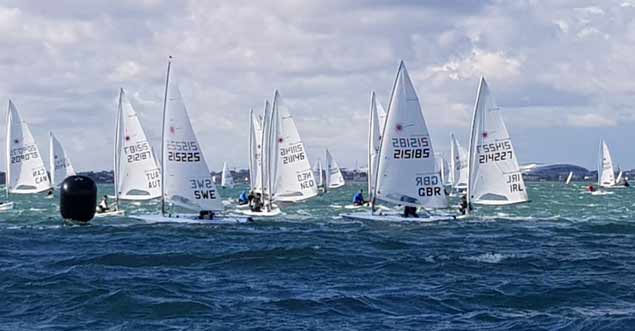 Lasers round a leeward in the second of Friday's races Photo: Neil Colin
Lasers round a leeward in the second of Friday's races Photo: Neil Colin
At face value, at least half of the 14 divisions have undisputed leaders that appear certain to win world titles after Saturday’s 12th race. But following a week of fresher winds, there may yet be an upset to the standings and much hinges on the two final races.
However, there is little to doubt the mastery of seven overall leaders, most of whom are counting consecutive race wins and podium placings.
Saturday's final race will also count as the "Bart's Bash" attempt to be the largest sailing event in 24 hours at multiple locations in aid of the Andrew Simpson Sailing Foundation.
Sweden’s Tomas Nordqvist delivered a strong challenge to Lyttle’s prospects with two wins for the day and in the process, overtook Spain’s Carlos Martinez who dropped back to third overall. Fourth placed Arnoud Hummel of The Netherland’s is also in the frame for a podium finish just three points off second place.
Amongst the Standerd rig Apprentice Masters, the week-long duel between Spain’s Leandro Rosado and Canada’s Gord Welsh is also down to the wire with both boats tied on 18-points apiece. The Irish battle for third place saw Howth Yacht Club’s David Quinn take over the place with three points separating him from Roger O’Gorman and Pete Smyth.
A drop in form for Bill Symes of the United States with a tenth and 20th in the 37-boat Radial Great Grand Master class might otherwise have done more damage to his prospects but for his main rival, Sweden’s Lasse Wastesson who didn’t fare much better and the American has a 20-point cushion going into the final day.
Of the divisions almost assured of no change to the leaderboard, the machine-like delivery of race wins even after a week of demanding conditions afloat continues to impress fellow-competitors and race followers alike.
Standard Master class - Brett Beyer of Australia, two more wins means an emphatic 20-point lead. Similarly, Standard Great Grand Master - Germany’s Wolfgang Gerz with two more wins for a 15-point lead. A third place then a win for New Zealand’s Scott Leith in the Radial Master class leaves him on the cusp of an eleventh world championship title. Two second places for Britain’s Stephen Cockerill still won him the day amongst the 58-strong Radial Grand Master class with a 20-point lead.
Britain’s Ben Elvin surely has the six-boat Radial Apprentice class won after two more wins today while Peter Seidenberg of the United States repeated his Thursday form with a third place and a race win to maintain his grip on the Radial Legends class.
Full results are here



























